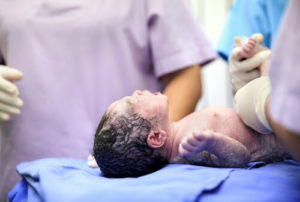Abnormal Presentation and Breech Birth

Historically, a breech or an abnormal presentation were very dangerous conditions for both mother and baby. However, medical advances have significantly decreased the risks that these conditions pose. Although modern medicine has ensured that many babies who presented in an abnormal way or in the breech position are born without any problems, your baby suffered a terrible birth injury.
A doctor should be able to determine when your baby enters the birth canal in an improper position, and will either adjust the baby’s position, determine if a cesarean section (c-section) is the most appropriate option, or prepare for an assisted delivery. If the doctor does not make the correct decision, then you and your baby may suffer extreme harm. If you or your child suffered at the hands of negligent medical professionals, please call Stern Law, PLLC (800) 462-5772 for free discussion of your legal options.
Breech birth and abnormal presentations
In a normal vaginal birth, the baby presents head first in the birth canal. If the baby presents with any other body part first, including feet or buttocks, then it is considered an abnormal presentation. When this happens, there are special medical protocols that must be followed by doctors and other medical professionals.
There are other ways in which a birth can be considered an abnormal presentation, even if the baby’s head presents first. If the baby’s head is in the birth canal first, but the baby’s chin is not tucked into the baby’s chest, then this is a brow presentation. If the head is tilted so far back that the face presents first it is called a face presentation.
Another abnormal presentation occurs when the baby is shifted so that it is facing the mother’s abdomen rather than her back. The baby may also present by entering the birth canal in the sideways position. Of all of the possible abnormal presentations, breech is the most common problem faced by medical professionals. Both the mother and baby can suffer harm with an abnormal presentation.
There are three different types of breech birth:
- Frank breech – The baby enters the birth canal with the buttocks down and the legs pressed up against the body and the feet are by the baby’s head.
- Complete breech – The baby enters the birth canal with his or her buttocks down and legs up, yet bent at the knee so that the feet are pressed close to the baby’s buttocks.
- Footling breech – The baby enters the birth canal with one or both feet pointed down and entering the birth canal first.
What happens with a breech or abnormal presentation during labor?
An abnormal presentation is not uncommon, but the doctor and other medical professionals need to diagnose the condition and carefully monitor the situation during the labor and delivery process. Many times an abnormal presentation will correct itself during the labor process. The doctor needs to be ready to respond appropriately if the abnormal presentation does not change position before birth.
If the doctor is properly monitoring an abnormal presentation, he may attempt to change the baby’s position by pressing gently on your stomach in an attempt to manipulate your baby into the proper birth position. If this does not work, it may be appropriate to schedule a cesarean section.
There are times when an abnormal presentation will not become known until the time of delivery. If this happens, the doctor must make the decision for an emergency cesarean section in a timely manner.
Symptoms of an abnormal presentation
A breech or abnormal presentation may be discovered during a doctor’s examination by manually feeling your uterine and abdominal areas. A doctor also may be able to determine the position of the baby by listening for the baby’s heart rate in relation to the birth canal and uterus.
There are certain risk factors for an abnormal presentation, of which a pregnant woman’s doctor should be aware. These include:
- Placenta previa – The placenta has developed on top of or too near the cervix.
- Abnormalities in the amniotic fluid – This includes too little or too much amniotic fluid.
- Your previous childbirth history – This is especially important if you have had premature deliveries.
There are many problems that can result from a breech or abnormal presentation. These include umbilical cord prolapse, a condition resulting from the umbilical cord dropping into the birth canal before the baby. Once this has happened, the birth process can put pressure on the cord and lead to oxygen deprivation in your baby.
If the doctor does not choose to order a cesarean section, a breech or abnormal presentation can necessitate an assisted delivery. This means that the doctor may need to use forceps or a vacuum extraction to ease the baby through the birth canal. Although these medical tools are a valuable advantage to doctors during the delivery process, they also may cause injuries to the baby.
For more information about birth injury litigation, please call Stern Law, PLLC at (800) 462-5772. Our firm is available to answer your questions free of charge.







